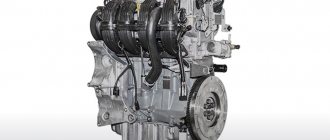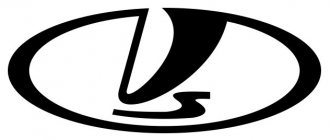Electric power steering in a modern car is an indispensable option. The EUR of the Lada Vesta reduces the force applied by the driver to the steering wheel when turning. Of course, one can argue for a long time about which is better - hydraulic or electric power steering (aka power steering), but the fact remains: a device that reduces the force required to turn the steering wheel provides comfort for the driver when maneuvering.
The EUR appeared not so long ago, but has clearly established itself as an improved version of the “old” amplifier - with increasing speed, it reduces its efficiency, thereby saving battery charge. Electric power steering Vesta is a pleasant gift from the domestic automobile industry.
What happened to the resource?
The resource value for the VAZ-21127 engine is 200 thousand km.
In reality it is more. The engine must run all these “thousands” without replacing parts: only the belt tension is checked, the oil is changed, and there is no need to replace the timing belt. Find out more about whether valves bend in a Lada Vesta engine here.
There is no need to “adjust the valves,” since the 16-valve engine is equipped with hydraulic compensators. Everything that is said here also applies to the latest VAZ development - the 21129 engine.
Note that the 27th and 29th engines do not differ much, while the second of them is operated in a more gentle mode. And this means that its resource will be at least no less than that typical for the ICE “21127” - 200 thousand and above!
Instructions for luxury equipment, which has gray wires
Sequencing:
- There are holes on both sides of the Lada Vesta steering wheel. Insert the rods into them and press.
- The base of the airbag rises. You need to carefully remove it.
- Carefully separate the wires.
- Unscrew the central locking screw and pull the control wheel towards you without any effort. The wires should exit through the hub opening.
- If it is necessary to install the steering wheel, carry out all the steps in reverse order.
The steering wheel in the car is locked tightly. Therefore, when removing it, do not make any effort, gently swing it.
Test the correct connection. All keys must function as intended. If the backlighting of the cruise control keys does not function, then a flashing is required. After checking, the airbag is installed.
What exactly has changed in the design?
In appearance, motor 21129 looks very modern. In its design, for example, there is a pressure sensor (DBP) combined with an air temperature sensor (ATS). The damper of the resonator chambers is controlled by a pneumatic drive.
All these elements are also present in the design of another engine - the VAZ 21127. And it was possible to improve the performance without increasing the displacement using the following methods:
- The “piping” was redone - exhaust, resonant intake, controller program;
- The design uses lightweight pistons: an alloy with aluminum is used for manufacturing, the piston skirts are shortened, and recesses are made in the bottom for the valve plates;
- Both compression and oil control rings have become thinner than on all previous engine models. Friction losses have decreased.
Pay attention to “point 2”. It does not follow from this that the ability to bend the valves is now absent. Don't draw false conclusions!
Basic faults
The electromechanical power steering system of the Lada Vesta has its own shortcomings, which then do not manifest themselves in the best way - sometimes even while driving. By the way, the EUR Vesta has a peculiarity - at speeds above 70 km/h it may seem that the car is “floating”, but in fact it is the sensors that react so sensitively to steering movements.
When you start the engine, the yellow steering wheel icon with an exclamation mark will light up on the dashboard for three seconds. This is normal - a normal sensor check. But if after three seconds the icon does not burn out, this will mean that the system has failed, and you should not start driving - at a minimum, you should connect to the diagnostic connector to find out what the problem is.
The electric booster may turn off while driving due to a short circuit in the wiring. It is usually preceded by a slight knocking sound in the steering wheel - if you feel this kind of rattling, be prepared to slow down and stop. Disabling the EUR while driving at a decent speed leads to the steering wheel spontaneously turning to the side, and the car can eventually slide into the adjacent or even oncoming lane.
A shorted wiring is caused by the fact that the harness under the hood is not protected from moving parts and ends up rubbing against the steering driveshaft. You can prevent the problem if you remove the battery terminal, harness and cover the wires with a corrugated tube - both from ingress of large amounts of moisture and from mechanical damage. If a breakdown occurs, replace the blown EUR fuse.
If you cannot diagnose it yourself, contact an authorized dealer and insist on a real check. As the experience of Vesta owners shows, the official dealer checked the suspension, released the car with assurances that everything was in order, and did not look for the real reason for the rattling in the steering wheel. Defend your point of view so that the defective power steering unit is checked and replaced.
Problem
Lada Vesta is a new model, and like any new product, it is gradually getting rid of its shortcomings. However, as the experience of the owners of this sedan shows, sometimes flaws in the assembly can lead to very unpleasant consequences.
One of these situations arose with Viktor Smirnov, who drives his Lada Vesta Mouse gray and is known in the Drive community under the nickname avtokurier.
During one of the trips, he noticed that there were jerks on the steering wheel to the right, after which a cracking sound began to be heard under the steering wheel and at the same moment the electric power steering stopped working. Naturally, the steering wheel immediately became heavier. In such a situation, an indicator in the shape of a steering wheel lights up on the Vesta dashboard.
The steering wheel may suddenly become heavy while driving.
This situation ended happily, which is good news, but the consequences could have been much worse. After all, if Vesta’s electric power steering turns off on the highway when the car is driving at high speed, and even while cornering, the driver may become confused and lose control of the car from surprise, especially if he is not very experienced.
Engines
The LADA Vesta engine range is so far even narrower than that of the Priora, as it includes only one engine. The basic version of LADA Priora has an 87-horsepower, 8-valve, injection power unit, the installation of which is planned for Vesta in the future, in order to reduce the price of the latter. In the Priora, this engine produces peak power at 5,100 rpm, and at 3,800 rpm there is all 140 Nm of torque.
The second engine, which is a 106-horsepower 16-valve engine, is available on both models. This is a domestic development of the VAZ-21127 type with an injection power system. Its power is noticeably higher, but it is achieved later - only at 5,800 rpm. But the torque increased slightly - by only 8 Nm (up to 148 Nm), and the speed also increased (up to 4,200 rpm).
And it’s worth admitting that with it, LADA Priora turned out to be even more dynamic than its fresh competitor – 11.5 seconds. versus 11.8 sec. when accelerating to hundreds. The same applies to the maximum speed – 183 km/h and 178 km/h. And if we compare it with Vesta, equipped with AMT, the situation turns out to be even more depressing (12.8 seconds and 178 km/h, respectively).
This completes the list of available engines. But it is worth noting that AvtoVAZ plans to equip the Lada Vesta with a 1.6-liter Nissan engine of the HR16DE-H4M type, derated to 110 hp. With. In addition, there is also a 1.8-liter unit with a capacity of 122 hp. With. With these engines under the hood, the new product of the Russian concern will not leave a single chance for its rival in terms of dynamics, maximum speed and efficiency. Moreover, equipping Vesta with a 1.8-liter engine should begin in the fall of this year.
As you can see, at the moment the LADA Priora has a slight advantage, which is largely achieved due to its lower weight. But in the near future the situation will change dramatically.
Self-replacement of the fuel filter on the Lada Grant
No special keys are needed, everything is done as standard and without problems with your own hands.
First of all, turn off the fuel pump fuse, start the engine, let it run until it stalls. If it stalls, it means there is no pressure in the system, you can start.
We drive the car into the pit or climb under it on the right. The filter is located near the fuel tank, something like this picture:
Press down on the metal clamp fittings to loosen the fastening and at the same time pull the hoses to the sides. Now you can remove the filter from the clamp:
Next, install a new fuel filter, attach the fittings in place, put them on properly until they click:
We put the fuse back in its original place and try to start the engine. If it doesn’t start, then repeat fuel injection again. The engine started and ran smoothly, which means everything was done correctly and you can drive.
In a Lada Granta car, two filters are used to purify fuel: fine and coarse. They differ slightly in your purpose, and are completely different from each other in design. For example, a coarse filter serves to retain large debris from the gas tank, and is installed in the form of a fine mesh on the outlet pipe. But the fine fuel filter serves to retain smaller debris, and also purifies gasoline, removing water from it. The structure of this cleaning element is more complex, as it consists of several elements. This type of fuel purifier will be discussed in this article.
Why was the 27th engine replaced with the 29th?
The VAZ-21127 engine was good for everyone, except for one thing - it complied with Euro-4 standards. For Vesta sedans produced from November 2022, this option would not be suitable. It was necessary to solve a difficult problem: to improve the environmental class without increasing the volume and without losing power. And as a result, a new family of 16-valve engines appeared in the VAZ arsenal. We are talking about motors 21129 - they really meet the latest environmental standards.
New Lada: Lada Vesta tie rod ends Lada Vesta, set of 2 pcs.
To move to the Euro-5 standard, engine 21127 had to be modified:
- The resonant intake system, as well as the exhaust system, have been completely redesigned;
- The ECU controller (ECM) has received new firmware - even the algorithm that regulates the volume of the resonant chambers has been changed;
- Engines 21127 and 21129 have slightly different compression ratios - 11.0 versus 10.45;
- The engine suspension was also improved: it became possible to mount it on a subframe.
It is clear what kind of engine the Lada Vesta would have had in 2022 and later if not for the transition to Euro-5. It would be the VAZ-21127 internal combustion engine, but with a modified suspension. And now we see that almost everything has been improved. As they say, changes are obvious.
Tightening torques for threaded connections
| Name of parts | Tightening torque, Nm |
| Steering wheel bolt | 44 |
| Steering rack mounting bolts | 105 |
| Tie rod end locknut | 50 |
| Tie rod end pin nut | 37 |
| Tie rod ball joint housing to steering rack | 34 |
| Steering shaft universal joint bolt nut | 21 |
| Driver airbag mounting screws | 6,5 |
| Driver's airbag mounting nuts | 8 |
Interior
After the restyling, the interior of the Lada Priora became much more expressive and modern. A new dashboard, a large display in the middle of the dashboard, an updated center console - all this has ennobled the interior of the sedan. But the same features of the panel, the same gear lever, steering wheel, seat upholstery, flaws in the assembly and other points remind of the previous interior of the car.
Vesta's salon is fundamentally different. A completely different design, created in the style of modern foreign cars, a large display that fits harmoniously into the interior, and does not break out of it, as in the Priora, an impressive dashboard, high-quality operation of the climate system, well-profiled seats with good lateral support, space, etc.
In general, the interior of the LADA Priora is acceptable, but after Vesta it leaves a clear feeling of unfinished and lack of harmony.
Classic gur
Additional friction worsens the self-return of the steering wheel and feedback from the road, making the steering wheel weak and uninformative. But the engineers partly neutralized these points. They increased the castor on modern cars (the longitudinal inclination of the axis of the front struts) and worked their magic on the hydraulic part of the amplifier: they changed the geometry and characteristics of the spool valves. Fortunately, only mechanics rule the roost here. However, a person who has driven a passenger car with a steering gear will still feel a clear difference.
When operating such amplifiers, the hydraulic part causes the most trouble, for example: leaks of oil seals and external lines; wear of the power steering pump. However, the lion's share of problems is associated with inadequate intervention. When simply replacing steering rods, servicemen are too lazy to install the boots correctly, using ordinary plastic ties instead of standard metal clamps.
As a result, moisture gets into the rail, causing corrosion. In advanced cases, repair will no longer be possible and the unit will have to be replaced once assembled. We wrote about this in detail in the material about the main faults and repairs of steering racks. In general, today the classic power steering causes the least amount of trouble and requires reasonable repair costs compared to other variations of amplifiers.
Description
The steering rack is mounted on the front subframe, which reliably protects it from possible impacts on road irregularities, but at the same time prevents access to it. Therefore, in case of repair, it will be necessary to remove the steering rack assembly with the front subframe.
1 – outer tie rod end; 2 – lock nut; 3 – clamp for fastening the rack cover; 4 – inner tie rod end; 5 – steering rack; 6 – steering mechanism; 7 – clamp for fastening the rack cover; 8 – steering rack cover.
The steering column is assembled with electric power steering, which only works when the engine is running. The efficiency of the EUR depends on the speed of the vehicle. The steering column bracket (No. 3) is attached to the body and is pivotally connected to the steering column tube. The bracket is equipped with a mechanism for fixing the steering column. By moving the locking lever (No. 2) to the upper position, you can change the angle and height of the steering column. When the lever is lowered, the column is fixed in the selected position.
The rotation of the steering wheel is transmitted through the steering column shafts to the steering gear, which meshes with a movable rack. The steering rack is connected to the steering knuckle arms by steering rods, through which the front wheels of the car turn. The length of the tie rods can be changed by screwing or unscrewing their ends (fixed with a lock nut), thereby adjusting the toe-in of the front wheels.
Options and cost
Lada Priora has half as many versions as Vesta - 3 versus 6. In addition, the described advantages of the new sedan over its predecessor can largely be explained by the difference in cost. The starting price of LADA Priora is 389,000 rubles, while for LADA Vesta it is 514,000 rubles. For class B cars the difference is 125,000 rubles. very weighty.
In the table you can see the differences in the equipment levels of the models:
As you can see, the difference in equipment is quite significant. As a rule, the Lada Priora does not have half the options that the Lada Vesta has, which is especially noticeable in the level of safety. If we remove the issue of cost from the agenda, then a potential buyer should definitely look towards the Lada Vesta - it is of better quality, more comfortable, safer, more attractive and technically more advanced. And the difference in price is quite appropriate.
AvtoVAZ is developing its 16-valve engines gradually, that is, step by step. When the updated Kalina family appeared in 2022, buyers were perplexed as to why they offered a 106-horsepower engine in manual trim levels, which differed little in design from the usual Priora engine.
New Lada: Review of the AMT robotic gearbox - disadvantages and advantages, test drive of the updated robot from VAZ
The new engine was equipped with resonant supercharging, and it seemed that its presence would only have disadvantages: reliability was reduced, there was no way to connect the cable drive. But it turned out that the new engine was no worse than its predecessor: the mass air flow sensor often breaks down, and the DBP and DTV sensors almost never. There is no MAF sensor in the design of the 27th engine, which is the secret of increased reliability.
By the way, Lada Vesta with a Nissan engine is getting ready for release!
Prestige and body
It is not entirely appropriate to talk about prestige in this case, since both models belong to the same brand. However, the Lada Vesta is definitely higher in status. After all, this is the first domestic model, which there is no shame in placing on the same level as foreign cars of the same class. In addition, this particular car literally destroys established stereotypes about the insufficiently high quality of Russian cars.
In terms of body styles, there is also an equal sign, since both models are offered exclusively in a sedan body. Previously, Priora was also sold in hatchback and station wagon bodies. But now its line has narrowed significantly. Vesta is just beginning her journey. As AvtoVAZ promises, a station wagon will roll off the assembly line in the fall of 2022, followed by a hatchback and a version of the Cross car.
If we compare the dimensions of competitors, it is noticeable that LADA Vesta is superior to its counterpart in all respects.
Model parameters. LADA Vesta - LADA Priora:
— length – 4,410 mm versus 4,350 mm;
— width – 1,764 mm and 1,680 mm;
— height – 1,497 mm versus 1,420 mm;
- ground clearance - 178 mm and only 165 mm for Priora;
- trunk volume - 480 liters versus 430 liters.
— weight – 1,230 kg (1,670 kg) versus 1,163 kg (1,578 kg).
The wheelbase of the new model is also noticeably wider and amounts to 2,635 mm, while the competitor has only 2,492 mm. The tracks of the front and rear wheels differ just as strikingly - 1,510 mm (front) and 1,510 mm (rear) for Vesta versus 1,410 mm (front) and 1,380 mm (rear).
How to choose?
Before you buy a leather steering wheel for Vesta or X-Ray, you need to study this issue in order to navigate the many offers from different manufacturers. All braids are sewn from automotive leather, 1 mm thick. This leather is tougher, making it more resistant to wear and mechanical damage.
As a rule, there are 4 categories of goods on the market:
- Standard - products are made of artificial German leather Schweitzer Nappa, exclusively in black. The braid is smooth in combination with perforated. You can also choose any thread color. Price – about 1200 rubles.
- Normal - genuine Russian Vista Uruguay leather is used, only in black. The braid is smooth in combination with perforated. Threads are available in different shades. The cost is about 1600 rubles.
- Luxury - made from genuine Russian leather Vista Uruguay. A combination of different colors with different thread colors is available. The braid is smooth in combination with perforated. Approximate price tag – 1900 rubles.
- Premium - genuine Italian Nappa leather, without perforation, but various combinations of colors and threads are available. Italian products cost about 2,300 rubles.
An example of a leather steering wheel braid. As practice shows, products of the Norma class are the most popular.
And this is more than reasonable, because not every Lada owner wants and can afford Italian leather, but most will not buy goods made from artificial material. It is also worth buying only those steering wheel braids that are cut for a specific model, since in this case the geometry of the steering wheel is also taken into account. It is not recommended to purchase generic goods if you come across them, because their quality is quite low and the amount saved in no way compensates for this lag.
The steering wheel braid of the Lada Vesta and X-Ray is designated size “M”, which is equal to 37-39 cm.
For Vesta and X Ray, a class M product is suitable
Steering
The reference system is a hydraulic steering gear. This is a mechanism of the so-called “screw-ball nut” type. It is often used on trucks and buses, but previously it was also installed on expensive sedans, for example on Mercedes-Benz with body index W124. The mechanism has minimal internal friction and is complemented by a hydraulic booster.
When you turn the steering wheel, the input shaft of the gearbox with helical grooves rotates. The same ones are made on the inside of the nut attached to it. The rotation of the shaft causes its axial movement. The outer part of the nut is connected by teeth to the output shaft of the gearbox. Thus, its axial movement is again converted into rotational movement. Friction in the input shaft-nut pair is reduced due to the circulation of balls in the grooves. Essentially, this is a bearing assembly.
Alas, with the massive advent of conventional steering racks, internal friction inevitably increased, and with the advent of electric amplifiers (electric motors), parasitic moments of inertia were also added. Since then, engineers have been trying, with varying degrees of success, to instill in modern mechanisms the standard information content inherent in passenger steering gears.
Electric power steering
Electric power steering (EPS) has recently become increasingly popular. Its main advantage is high reliability and low noise during operation. The design of such a mechanism is quite simple: the entire unit, as a rule, is located under the steering column. As soon as you apply force to the steering column, the automation detects this and the electric motor turns on, which “helps” turn the wheels.
There is also such a variety as electromechanical power steering. This type of electric amplifier is distinguished by the fact that it transmits force through a gear or belt drive.
The main malfunction of this type of amplifier is damage to electrical equipment: fuses, relays, electric motor, wire connections. Repairing such units is much cheaper than repairing other types of power steering mechanisms.
Thanks for subscribing!
Specifications
All parameters related to motor 21129 are listed in list form:
- The working volume is 1.596 l;
- Compression ratio – 10.45;
- Power (nameplate value) – 106 hp. at 5800 rpm;
- Maximum torque – 148 N*m at 4200 rpm;
- Maximum shaft speed – 6200 rpm;
- Oil change intervals – 15,000 km;
- Crankcase volume – 3.2 (2.9) or 4.4 (4.1) liters, the first option is for the “AMT” gearbox;
- Oil viscosity – from 0W30 (0W40) to 20W40 depending on temperature;
- Engine life is 200,000 km.
For one liter of fuel consumed, there is up to 3 ml of oil. These figures are indicated in the VAZ documentation. This means that 240-250 ml will be needed per thousand km. Nissan engines (HR16DE) consume twice as much.
Now let's analyze what is shown in the graph. The motor develops a force exceeding 130 N*m in a wide range: from 2300-2400 to 5900 rpm! This means that the traction will be very “elastic”, which is exactly what is needed for configurations with “AMT”.
At low speeds, not exceeding 1800 rpm, the tractive effort value “tends to zero,” which is typical for most 16-valve engines. But we are talking about what kind of engine is in the Lada Vesta - this is not an SUV, where “low-end traction” is very important. Cover with your hand the part of the graph located in the first quarter - you will get the load curve of the “ideal engine”.
Transmissions
The Priora has only one gearbox - a 5-speed VAZ-2181 type gearbox. Despite the fact that the gear ratios in it are selected quite competently, the unit does not differ in particular driving comfort. The lever is not very conveniently located, and during shifts it often rests against the driver’s seat or leg. In addition, it vibrates when driving, which makes shifting difficult and discourages the desire to touch the lever again.
The list of Vesta transmissions is noticeably wider. It has a domestic, 5-speed “mechanics” type VAZ-2180, which was inherited from Priora. However, this gearbox was seriously modified using foreign components. In particular, a gear shift module from Schaeffler (Germany) was used.
The second manual transmission is a French gearbox of the JH3 510 type. It also has 5 gears and in terms of quality of operation it is in no way inferior to the VAZ gearbox - the shifts are clear, the lever is quite short-throw, and there are no cases of gear slippage.
New Lada: How to protect the gas tank flap, install an electric lock on the LADA
And LADA Vesta also has an AMT-type robotic gearbox in stock. Although this is not a full-fledged “automatic machine,” the “robot” still fully justifies its choice. Shifts are timely and logical, fuel consumption is also quite acceptable. In traffic jams, AMT changes gears more noticeably than automatic transmission, but this is not critical and most of those who decided to buy a Vesta with a “robot” are quite happy with it.
Chassis
From the point of view of design solutions, everything is identical. Both Priora and Vesta have standard MacPherson struts at the front, and a torsion beam is placed at the rear - a common thing for class B. But the chassis settings differ significantly. Despite the fact that the ground clearance of the Lada Vesta is noticeably higher, the handling of the new product is much better.
Of course, we cannot say that the handling of the LADA Priora is terrible. For measured driving around the city and on the highway, it is quite enough. But during sharp turns and at high speeds, there is a lack of precision in reactions, feedback on the steering wheel, etc.
Egur - electro-hydraulic booster
Electric power steering is just a variation of the classic hydraulic booster circuit with the same driving sensations and problems in general. The only difference is that instead of a mechanical pump, an electric one is used. Otherwise, it is the same hydraulic rack and circuits. However, when you try to dig deeper, a lot of hidden differences emerge, some good and some not so good.
Such a system has a separate control module. The trouble is that it is combined into a single assembly with a pump electric motor and its hydraulic part. On many older machines, the tightness of such a sandwich is broken and moisture or even oil itself gets into the electronics. This happens unnoticed, and when it comes to obvious problems in the operation of the amplifier, it is already too late to try to repair something. You will have to change expensive elements.
On the other hand, such a scheme with its own control unit, unlike the classic power steering, has an important advantage - a kind of “fool protection”. If for some reason there is a large oil leak from the system, it will turn off the pump itself, preventing its sudden death due to dry operation. As is the case with a classic hydraulic booster, any blood loss does not result in wear and tear of the elements in the rack itself.
Reviews
What feedback can you leave about Vesta’s steering?
See also the Lada Vesta maintenance regulations.
Categories of products that may be of interest to you based on the article “Lada Vesta Steering (device, reviews)”:
Any modern car has a component called power steering. Its main task is to reduce the force used by the driver to rotate the steering wheel. This greatly increases the comfort level of the car. Just 15-20 years ago, power steering was a real highlight when buying a car in Russia and the CIS. Today, any car, even in its basic configuration, has this element. There are several types of power steering:
- hydraulic power steering
- electric power steering
- electrohydraulic power steering
- mechanical power steering
- pneumatic power steering
The structure and operation of each type is fundamentally different. The pneumatic amplifier is a thing of the past and is now practically not used. The remaining options, especially electric power steering and hydraulic power steering, can be found on many cars.
Exterior
The appearance of the cars cannot be compared. Vesta is a stylish and modern model, with slanted headlights, an aggressive radiator grille, a sloping hood, a powerful air intake and the inevitable chrome lines designed to form the letter “X”, making the full face more recognizable.
From the side it looks no less impressive. Of course, the x-shaped stampings that run along all the side panels will bring a lot of trouble to tinsmiths in the event of restoration after an accident (most likely, the part will have to be replaced with a new one), but if you didn’t want to think about the bad, then this image, complemented by beautiful wheels, definitely impressive.
There is no dissonance at the back either. The sharp angles and straight lines of the lights harmonize perfectly with the simple and clear outlines of the trunk lid and rear bumper. And the decoration of the car is large, chrome-plated LADA letters.
Priora doesn't look so fresh. And in general, its appearance resembles an outright plagiarism of Japanese and Korean models of the early 2000s (such as Lancer 9, etc.). A “rare-toothed” radiator grille, convex headlights, a stepped bumper shape, beaded fog lights and other elements that seem archaic compared to modern cars.
From the side the car looks good. A straight line running across the entire sidewall, a curve along the bottom of the doors, nice wheels - nothing special, but nothing superfluous either. The same applies to the stern - the feet, trunk and bumper are simple and unpretentious. The only thing that dilutes the picture is the chrome on the trunk lid.
Electric power steering (EP), built into the steering column
With the advent of pure electric amplifiers, a parasitic moment of inertia was added to friction losses in steering mechanisms. Instead of hydraulics and a pump, electric motors came, built into the rack itself or standing outside it. Thanks to their rotation in one direction or another, assistance is provided when turning the steering wheel.
However, the rotor of any electric motor has its own mass and, therefore, a moment of inertia. Therefore, it is impossible to instantly stop it and change the direction of rotation. Electronics need time to adapt. This moment is expressed in temporary additional resistance on the steering wheel when a person abruptly changes the direction of its rotation while driving.
In addition, most amplifier circuits with an electric motor are also equipped with a worm gearbox. In particular, this applies to systems where the EUR is built into the steering column. Because of this, friction losses further increase. As a result, the information content of the steering wheel drops even more than in the case of a hydraulic booster.
In the circuit with amplifier elements in the steering column, we have a conventional mechanical rack. The simplicity of its design is much preferable to a complex and technologically advanced hydraulic system. However, this medal also has a flip side. In the event of internal corrosion, a conventional rack will remain silent until the last moment, until the shafts rot catastrophically and there is nothing left to repair. The hydraulic unit will very quickly begin to leak due to wear of the seals, and restoration will cost a fortune.
In defense of this type of EUR, we can add that the electronic part in the steering column fails extremely rarely. And in terms of resource, the system as a whole is comparable to its conventional hydraulic counterpart.
Power steering
Perhaps the most common type of power steering mechanism is the hydraulic booster (power steering). An additional unit is installed on the car engine - a power steering pump. This pump creates special oil pressure, through which elements move in the rack. When the steering wheel is stationary, oil is pumped freely around the steering rack. As soon as you turn the steering wheel a little, oil under pressure enters the corresponding part of the mechanism. The wheels turn, the distribution mechanism returns to its original position, and the oil again begins to bypass the rack.
The main power steering malfunction is oil leakage through the seals and hose joints, as well as a malfunction of the pump itself. Usually the pump fails after running dry. Thus, from one fault follows another. To avoid this, check the oil level periodically.











